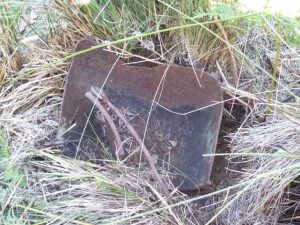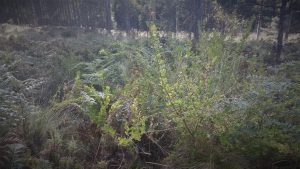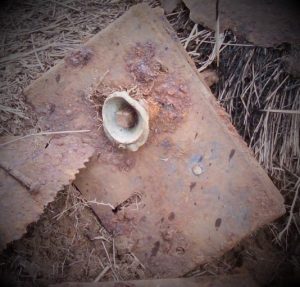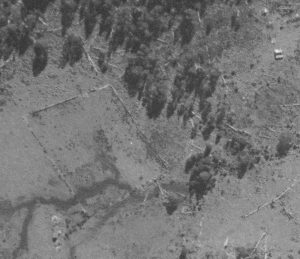In the period 1915–22 a veteran Field stockrider William Bonney (1857–1935)1 was the resident stockman at Old Gads Hill Station.2 Molly Pedley, née Field, recalled a trip to his hut. With typical bush hospitality, Bonney boiled the billy—but shocked his visitors by stirring the tea with his false teeth.3
While that story suggests the habits of a crusty old bachelor, Bonney was actually married with ten children, the last being born at Launceston in 1915. Perhaps his wife Alice Bennett and the kids hadn’t yet joined him at the time of Pedley’s visit, but the family certainly lived there together later.
This 1950s aerial photo shows the hut at Old Station (bottom left), the rectangular horse paddock to its right, and Mark and Bertha Shaw’s farm (top right). Aerial photo 016_496 (DPIPWE).
And why not? They were well set up, with two stables, hayshed, chaff house, slaughter house and, presumably, a skin shed.4 The house had a huge stone fireplace with stone hobs, allowing some of the six resident children—Arthur, Albert, Lindsay, Millie, Dolly and Lena—to sit virtually inside the fireplace.5 In addition, there was accommodation for at least six visiting stockmen, and the arrival of riders (typically Arthur Collins, Dick, Frank and Humphrey Brown) with a mob of cattle was a signal for the convening of a bush party. With Mark Shaw (1875–1963) wresting a tune from a squeezebox, Bill Bonney and his son Albert practised the step dance.6

At this time, the Shaw family lived on an adjacent 82-acre Crown purchase, enabling Mark Shaw to farm on his own account as well as assist Bonney with mustering duties. Shaw had a stockriding pedigree, being the son of former longstanding Gads Hill overseer Thomas Shaw, one of seven brothers formerly in Fields’ employ. He recalled that the art of mustering Fields’ wild cattle was to come upon them by surprise when they were grazing, then head them off before they could escape into the mountain fastnesses:
There were always a couple of recognised leaders among the bulls in any mob and as soon as they sighted the drovers they’d gallop for shelter, with the rest of the mob following. The drovers had no hope of pulling them up, so the idea was to keep them galloping in circles—‘ringing them’, they called it—till they tired and settled down.
Even when the mob had quietened, a bull might break away, necessitating the introduction of the bull-mastiff cattle dogs which were ‘specially trained to hold wild bulls’:
They’d run with the bull, worrying it, until it lowered its head to gore. Then the dog would grab the bull by the nose and hold on till the bull stopped. Then the drovers would bring the rest of the mob along and surround the runaway bull. When it was surrounded and jammed in by dozens of other cattle the dog would let go. And even that did not always work. I remember one bull we had to yoke to the bullock team to bring him along.7
When the cattle were driven down from Gads Hill to Mole Creek, residents took evasive action:
As soon as they saw us coming, mothers would grab their children and take them inside. It was the sensible thing to do. I remember once when we were passing through Mole Creek just after the railway had been built and the train arrived in. The mob just wheeled around and stampeded about three miles [five km] back to Sassafras Creek before we could pull them up.8
Twenty-one-year-old labourer Mark Shaw had married eighteen-year-old domestic servant Bertha Millicent Bramich at Sunnyside, Railton, on 7 December 1896.9 The first child, Evelyn, was born when Mark was stockriding for Fields at Borrodaile (Big) Plain, where the couple lived in a three-room house (Bertha spent her confinement with her mother at Railton).10 After that Mark Shaw built the three-bedroom timber house on Gads Hill. Eventually there were eleven Shaw children, six boys and five girls, making in all thirteen people to accommodate.
Ethel Shaw (born 1908) vividly recalled growing up on Gads Hill. It was a dairy farm, with milk, cream and butter being produced for family consumption.11 Water was drawn from a well sunk on a spring. Supplies were hauled in by bullock team and dray from Deloraine—but on at least one occasion an Indian hawker also came calling. Bertha washed the family’s clothes at a washtub by the creek, boiling the clothes in kerosene tins over a fire.12 While Mark and Bertha had a kapok mattress, the kids slept on ‘ticks’ (improvised mattresses), which were chaff bags stuffed with cut grass. School was four kilometres away—downhill and uphill—through rain, hail, snow and shine.13
Bill Bonney and Mark Shaw both snared through the winter and, in fact, whenever they could get away with it, regardless of season. Shaw recalled seeing many thylacines (Tasmanian tigers) and even snaring a couple.14 On one occasion police raided the Shaw house looking for out-of-season skins. The Shaws were warned on the ‘bush telegraph’, and when the constable came knocking Bertha invited him into the living room where two kerosene cases served as chairs. ‘Come in, sit down.’ ‘Have you got any skins?’, asked the constable—who of course was sitting on a stash of dry possum skins concealed in the kerosene case. ‘No’, came the reply. There was a skin shed on the farm where Bertha skun the game, pegged out skins and even tanned some, and a search of the bedrooms would have revealed bedding of possum skins rugs, but with no fresh skins to be found the constable departed emptyhanded. Bertha’s skills with native furs were an essential part of family survival. She lined one possum-skin rug with red flannel and sold it to a Deloraine bank manager for £40, half a year’s wage for some people.15
Legendary hunter and highland guide Paddy Hartnett and his wife Lucy Hartnett operated a store at the base of Gads Hill until mid-1916. Paddy was a frequent visitor to the Shaw household at this time. Crushed by recent events involving the outbreak of World War One, it was evident by 1915 that Hartnett was descending into alcoholism.16 However, his reputation as a bushman was unblemished. On a frosty night in May 1918, when four-year-old Thelma Shaw wandered off from the farm barefoot, Hartnett’s availability to conduct a search revived her father’s hope of finding her alive:
‘”Don’t worry, Mark”, he used to say, “we’ll find her all right”. And somehow I believed him. She was found on the morning of the fourth day by Ted Bullock and Ted Clarke, and apart from a few bruises and cuts, there wasn’t much wrong with her … We found out afterwards that the poor little thing often saw the lanterns of the men searching in the dark, but she ran away from them because she thought they were spooks’.17

Ethel Shaw reckoned that her mother worked so hard that she simply wore out. Bertha Shaw collapsed while planting carrots in the vegetable garden of the Gads Hill house in 1926, aged only 48.18 She died with a rake in her hand, working until her very last breath.19
Eighteen-year-old Ethel, the oldest girl still at home, became her father’s housekeeper until she went into paid work, being replaced by her younger sister. Past 50 by this time, Mark Shaw had given up stockriding, deriving an income from snaring and raising fat cattle. Occasionally he guided a hiking party into the pre-Overland Track Pelion Plain region, which he would have known from his droving and snaring adventures. After Christmas 1929, for example, Shaw met Launceston bushwalkers Fred Smithies, Cecil (CK) Stackhouse and Alf Weymouth with two saddle horses and a pack horse for the two-day journey via Borradaile Plain and the Mole Creek Track to Pelion Huts. After spending two nights with the party, Shaw trudged out of Pelion Huts in pouring rain—carrying the saddles and other gear that his impatient horses had left behind when they started for home without him.20

When exactly the Shaw farm was abandoned is unknown, but Old Gads Hill Station ceased to be a residential site in the 1920s, after more than 80 years. The last known occupants were brothers Dick (18??–19??) and Frank Brown (1862–1923), along with Frank’s partner Louisa Brown. All three had previously lived and worked at Fields’ Middlesex Station.21 Frank Brown died of heart failure and pneumonia while setting snares on Bare Hill in 1923, his body being discovered by Dick Brown and Mark Shaw.22 The stories of how Fields shifted to ‘New Station’ Gads Hill and of the Brown family stockmen will be told in future blogs.
Copyright Nic Haygarth 2020
1 Presumed to be the unnamed male child born 9 March 1857, birth record no.1790/1857, registered at Port Sorell, RGD33/1/35 (TAHO), https://librariestas.ent.sirsidynix.net.au/client/en_AU/names/search/results?qf=NI_INDEX%09Record+type%09Births%09Births&qf=PUBDATE%09Year%091857-1863%091857-1863&qu=joseph&qu=bonney, accessed 8 February 2020. He died in July 1935, at 78 years of age. See his obituary (‘Country interests and district news’, Examiner, 26 July 1935, p.5).
2 Wise’s Tasmanian Post Office directory, 1915, p.185; 1916, p.192; 1917, p.191; 1918, p.195; 1919, p.201; 1921, p.126; 1922, p.129. See Bonney’s departure to live in Westbury (‘News of the north-west’, Advocate, 4 September 1922, p.4).
3 Molly Pedley, interviewed by Nic Haygarth c1995.
4 Ethel Walters, née Shaw, interviewed by David Bannear, 1990, What’s the land for?: people’s experiences of Tasmania’s Central Plateau region, Central Plateau Oral History Project, 1991, p.19.
5 Ethel Walters, née Shaw, interviewed by David Bannear, p.21.
6 Ethel Walters, née Shaw, interviewed by David Bannear, pp.3–4.
7 Mark Shaw; quoted by Kerry Pink, ‘New chapter in Western Tiers story will be for all to read’, Advocate, 12 January 1963, p.11.
8 Mark Shaw; quoted by Kerry Pink, ‘New chapter in Western Tiers story will be for all to read’.
9 Married 7 December 1896, marriage record no.714/1896, registered at Mersey, RGD37/1/56 (TAHO), https://librariestas.ent.sirsidynix.net.au/client/en_AU/names/search/results?qu=mark&qu=shaw, accessed 2 February 2020.
10 Ethel Walters, née Shaw, interviewed by David Bannear, pp. and 19. Evelyn Bertha Shaw was born 23 March 1897 at Railton, birth record no.1423/1897, registered at Mersey, RGD33/1/84 (TAHO), https://librariestas.ent.sirsidynix.net.au/client/en_AU/all/search/results?qu=evelyn&qu=shaw, accessed 4 March 2020.
11 Ethel Walters, née Shaw, interviewed by David Bannear, p.5.
12 Ethel Walters, née Shaw, interviewed by David Bannear, p.17.
13 Ethel Walters, née Shaw, interviewed by David Bannear, p.4.
14 Mark Shaw; quoted by Kerry Pink, ‘New chapter in Western Tiers story will be for all to read’.
15 Ethel Walters, née Shaw, interviewed by David Bannear, p.13.
16 See Simon Cubit and Nic Haygarth, ‘Paddy Hartnett: bushman and highland guide’, in Mountain men: stories from the Tasmanian high country, Forty South Publishing Hobart, 2015, pp.92–93.
17 Mark Shaw; quoted by Kerry Pink, ‘New chapter in Western Tiers story will be for all to read’. For a contemporary account of the incident, see, for example, ‘Liena’, North Western Advocate and the Emu Bay Times, 6 May 1918, p.2.
18 ‘Woman’s world’, Examiner, 17 March 1926, p.7; ‘Deaths’, Examiner, 13 March 1926, p.1.
19 Ethel Walters, née Shaw, interviewed by David Bannear, p.21.
20 Fred Smithies, ‘Notes on a trip to the Pelion and Du Cane Ranges Central Tasmania, Xmas 1929’, NS573/1/22 (TAHO).
span style=”font-size: 10pt;”
21 Commonwealth Electoral Roll, Division of Wilmot, Subdivision of Kentish, 1914, p.6.
22 ‘The dead stockrider’, Daily Telegraph, 7 June 1923, p.4.

I Am A Descendant Of The Shaw Family…I Would Love To Find Out More Stories About My Family I Found This Very Interesting…My Great Grandfathers Name Was William James Shaw Married Mary Jane Flukes…I Beleave His Farther Was James Married Martha Alice Pearce…
Does anyone know who owned or donated the land where the Liena state school was built about 1913 at 23 Old Gads Hill Rd., Liena. Is that the school referred to above?
School was four kilometres away—downhill and uphill—through rain, hail, snow and shine.13
Thankyou for your time.
Hello Susan,
the town grant chart from October 1901 shows the owner of the land being W Dunlop. More information may be available from a titles search. There is also a file at the Archive in Hobart “Proposed establishment of a school at Liena near Mole Creek.Item Number: ED9/1/565” that could have more information
Peter
Yes to your question, Susan.
The story is that the children had a track or path coming down off the Old Station/Old Park which they walked to school.
Mark Shaw had a 50 acre block that fronted Gadds Hill road, crossed over Ration Tree Creek and backed onto the cliffs below the Old Station.
He also had another 50 acres in Liena fronting the Mersey not far from the ford where the VDL Road crossed.
I have a copy of a photograph of the old original school house taken in 1934 (From memory) with the teacher standing out the front. The foundations of the school house are still there.
There was a Billy Dunlop who lived in Liena in the 1970s but I thought he owned the later school block down in Liena. I don’t know if there was a Dunlop before him.
Thanks for the interesting information Roger
Thank you Peter, I now realise I had the wrong school at Liena. I`m interested in the history of the 1900 Gads Hill school, at 210 Old Gads Road. The school not the building was removed to Liena & open in 1913 as more convenient to the town of Liena. Can you please tell me from the 1901 town grant chart who owned the land where the school stood at 210 Old Gads Road. Thank you for sharing all the stories about the pioneers of this area.
210 Old Gads Hill Road is not within the are covered by the Liena town grant chat. A title search would be your best option. This link gives some information https://nre.tas.gov.au/land-tasmania/land-titles-office/general-information/how-to-search-for-land-information/how-to-search-a-torrens-title.
Peter
It might have been Harry Glover, also one of Fields’ stockmen or Mort Warren
Thanks Roger